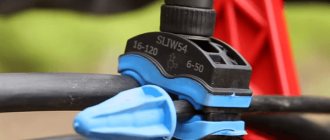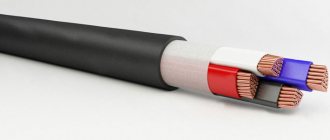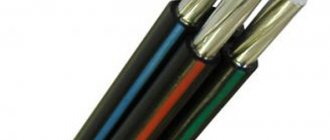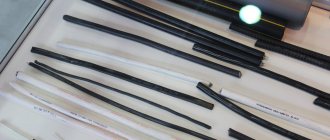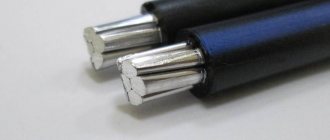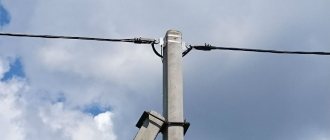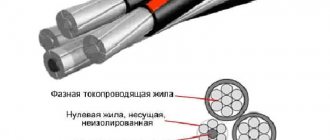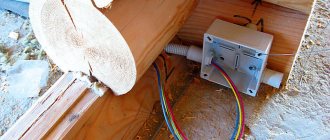Cable laid over the air
Often, to organize power supply in outbuildings, sheds, garages, and local areas, the cable is pulled through the air. If the wiring distance is more than 25 m, install additional support.
When laying a cable through the air, it is important to protect it from external influences: ultraviolet radiation, temperature changes, and precipitation. These factors negatively affect the most commonly used PVC braid, causing it to crack.
To extend the service life of the cable when laid overhead, it is enclosed in a corrugated metal or polyethylene pipe.
Ways to organize wiring inside the house
There are several options for performing internal wiring.
Connecting different cables inside
Wire welding
The SIP conductor is broken and connected to the VVGng cable by twisting and reinforcement by soldering. The technique is not reliable, as it can lead to fires.
Connecting various conductors with fittings
The coupling of SIP and VVGng is carried out using standard reinforcing bars, piercing clamps or other elements near the insertion point. It is unacceptable to use SIP in a residential area - it supports combustion processes.
Through the difavtomat
The connection diagram provides for the use of a two- or four-pole differential circuit breaker. The device is located in a separate sealed box. The cable is laid from the main line to the box and connected to VVGng in a corrugation.
To increase protection, a machine with a rating higher than the distribution board is used. This way, if there is a short circuit or overload, you can restore the line without leaving your home. Another device is installed outside, de-energizing the internal cable and preventing fire.
FAQ
Question No. 1. Is it possible to lay cables with a much larger cross-section than calculated according to the tables?
Yes, you can if you got them for free or very cheap, otherwise it’s an extra financial expense. In this case, take into account the possibility of inserting the ends into the control panel and securing them to the contacts.
Question No. 2. If there is a cable to be laid in the ground, can I lay it over the air?
You can, but you need to take into account its increased weight, be sure to use a cable suspension and the distance between the supports is preferably up to 10 m.
Question No. 3. Is it possible to lay AVVG cable in the ground?
Yes, this cable has reliable waterproofing, but without armored tape, so it must be laid in pipes.
Question No. 4. For a 380 V network, can two AVK cables be used?
To do this, you will need to connect the coaxial sheath of one cable to the third phase, and the sheath of the second cable to the grounded neutral; such a scheme is allowed.
Question No. 5. It is prohibited to lay a cable under the foundation, but can it be laid up to the shield along the wall so as not to drip around the building?
It all depends on the specific conditions at the site; when leaving the ground, the cable up to a height of 1.8 m must be in a protective box or pipe. Walk at a distance of 90 cm from windows and doors, if these conditions are met, do it.
The main operating parameters used to calculate the cable
To connect the cable to the house, you need to decide on its cross-section. The cable cross-section is its area at the cut site. Generally accepted standards (according to the PUE) are indicated in the previous section. The main operating parameters by which the cable cross-section is selected are its cross-section and rated current.
But in addition to the cross-section, a certain conductor material is also needed. Nowadays, copper wires are most often used; they have lower resistance, but are more expensive. Aluminum does not have such high conductivity, but its price is lower than that of copper products. It should be remembered that with the same load, the cross-section of the aluminum conductor should be larger than that of copper.
And the last parameter is the number of cores, but with this everything is much simpler. When introducing only one phase and a working zero into the house, a two-core cable is used; when introducing three phases and a zero, a four-core cable is used. In both options, the cross-section of the zero conductor may be smaller than that of the phase conductor.
Expert opinion
It-Technology, Electrical power and electronics specialist
Ask questions to the “Specialist for modernization of energy generation systems”
Cable for laying in the ground Multi-wire protection gives the cable high flexibility, which allows minimizing the risk of rupture of the BKZ during movements of soil layers on steeply inclined routes. Ask, I'm in touch!
Installation of external electrical wiring
Any technical work related to construction is carried out in accordance with the developed project, which is carried out by specialists. To connect to the power grid, you must submit an application to the energy supply service that serves the building area. The document must indicate the optimal power and voltage required by the user.
The numbers can be calculated based on the total power of the estimated energy consumption of all electrical appliances. Based on this data, the relevant authorities issue a permit in accordance with the technical data, which describes the permissible power, voltage, wire cross-section, grounding rules, as well as protective and fixing equipment.
To connect a house to a 15 kW power grid, a voltage of 230-400 V is required, and the meter must have the appropriate machines.
Why do you need to calculate the cable cross-section?
The following requirements apply to electrical networks:
- safety;
- reliability;
- efficiency.
If the selected cross-sectional area of the wire is small, then the current loads on the cables and wires will be large, which will lead to overheating. As a result, an emergency may occur that will damage all electrical equipment and become dangerous to the life and health of people.
If you install wires with a large cross-sectional area, then safe use is ensured. But from a financial point of view there will be cost overruns. The correct choice of wire cross-section is the key to long-term safe operation and rational use of financial resources.
A separate chapter in the PUE is devoted to the correct selection of a conductor: “Chapter 1.3. Selection of conductors based on heating, economic current density and corona conditions.”
The cable cross-section is calculated based on power and current. Let's look at examples. To determine what wire cross-section is needed for 5 kW, you will need to use the PUE tables (“Electrical Installation Rules”). This directory is a regulatory document. It states that the choice of cable cross-section is made according to 4 criteria:
- Supply voltage (single-phase or three-phase).
- Conductor material.
- Load current, measured in amperes (A), or power - in kilowatts (kW).
- Cable location.
what is the required wire cross-section for 3 kW
What wire cross-section is needed for 3 kW
In the Other services section, to the question How to determine what the wire cross-section should be for a 3.5 kW water heater? asked by Kochegar2 the best answer is The cable usually consists of 2-4 cores. The cross-section (more precisely, the cross-sectional area) of the core is determined by its diameter. Based on practical considerations, at low current values, the cross-section of the copper conductor is taken to be at least 1 mm2, and for the aluminum conductor – 2 mm². At sufficiently high currents, the wire cross-section is selected according to the connected power.
Simply put, if you have a 3.5 kW instantaneous water heater, then you need to connect it with a wire rated at least 15.9 A, and for a copper wire the cross-section should be at least 2.5 mm².
The cross-section of aluminum wires should be one step higher, since their conductivity is approximately 62% of the conductivity of copper wires. For example, if according to calculations for copper a cross-sectional value of 2.5 m⊃m is required; 2, then for aluminum you should take 4 mmI, if for copper you need 4 mmI, then for aluminum - 6 mmI, etc.
In general, it is better to choose a larger cross-section than according to calculations - what if you need to connect something else? In addition, it is necessary to check whether the cross-section of the wires is consistent with the maximum actual load, as well as with the current of the protective fuses or circuit breaker, which are usually located next to the meter.
Come here
Reply from 22 replies Hello! Here is a selection of topics with answers to your question: How to determine what the wire cross-section should be for a 3.5 kW water heater? What rating should I install a 4-pole circuit breaker on a 380V socket? Tell me for a 5.5 kW welding inverter Which extension cord on the reel should I choose, with what cross-section? tags: Equipment What cable cross-section is needed for a 6 kW EVN. 380 V copper cable. We know the CROSS SECTION of the wire and VOLT, how to calculate how many WATT the wire will withstand? for example, cross section 0.75, 12 volts tags: Experienced Dedovsk
Reply from Koshak
take 6*3 you won't go wrong
Answer from Iuslan Globazh
take with a reserve of more than 20a
Reply from Ololosh
Well, consider the student, divide the power by the voltage, we get a current strength of 15.9 amperes at a voltage of 220 volts, and then 4mm * 2, I think that’s enough because suddenly there will be short-term interference
Reply from Bosston
for 4 kW we take the cross-section of the copper core 4 sq. mm, the rated current of the protection device is 31.5 Amperes.
And you can determine it from the table of rated protection currents and cross-section of supply wires
Reply from Alrisha
It’s very easy to determine :) - 3*2.5
By the way, don’t forget that the water heater must be plugged into a grounded outlet, i.e. into the outlet from the washing machine (if there is one :)), if not, then buy a 16-amp machine (see what it looks like next to the meter) and a waterproof outlet with grounding and call an electrician - he will connect everything.
Reply from 2 replies Hello! Here are more topics with the necessary answers: in the bathroom there is a boiler and a washing machine, a 2.5 mm copper wire, there is a 16A machine on the panel. Is it worth changing to 25A tags: Equipment Areas of Van Will VVG 4x16 withstand a load of 50 kW? or do you need to select a VVG 4x25 cable??? tags: Equipment Cable production Can any knowledgeable electricians tell you how cables are supplied to the meter in Khrushchev-era buildings?! tags: Khrushchev technology What is the current and voltage in ordinary Russian sockets? tags: Equipment
https://youtube.com/watch?v=0o9x-5mPCuY
When will the lights be turned on?
So, you have a contract and specifications in your hands. The conditions list the measures that, by completing them, will bring the site in accordance with the requirements of the network company. Usually they are interested in the metering unit and the machines that disconnect the wires in an emergency. As a rule, the box with the meter is installed on a pole (pipe stand) on the outside of the site.
The video below shows an example of performing specifications
Pay attention to the budget pipe stand. You can install it yourself
In winter, connection is possible if the pole and wires are located close to the metering station. When additional wire supports need to be installed, the network company's lead time may be extended to one year. The deadlines for fulfillment of obligations by the parties are specified in the agreement.
What are electrical cables made of?
The main conductor of electric current is aluminum or copper conductors. The larger their diameter, the higher the cable's capabilities.
Aluminum wires are cheaper, but they are more likely to deteriorate and have a lower electrical conductivity coefficient.
Copper cable is durable, does not break at bends and is capable of carrying more current than aluminum cable with the same diameter.
It is recommended that all wiring in the house be of the same type. This is due to the fact that to connect products from different materials, a special adapter will be required so as not to create a galvanic couple. In this case, oxidation and destruction of the wires occurs, which can lead to a short circuit.
The main cores are covered in braids made of rubber, polyethylene or PVC. Often several of these insulated conductors are combined into a bundle, which in turn is covered with a protective sheath.
Electric installation work. Wires, cables and tools
Before talking about the rules for installing internal lines (groups) of house wiring, it is worth understanding the types of wires and their purpose.
An electrical wire is an insulated or non-insulated conductor of electric current, consisting of one or more wires (most often copper or aluminum).
Installation wire is an insulated electrical wire for electrical installation and hidden or exposed wiring.
Electric cable - several insulated electrical wires enclosed in a common protective sheath, and sometimes on top of it in a protective cover - a steel spiral tape (metal hose) or metal braid.
An electrical cord is a flexible cable with stranded flexible cores designed to connect electrical appliances to the network through sockets.
Bare wire may only be used for overhead lines.
The cross-section of the wire must be selected depending on the current passing through it (or power consumption).
For copper wires, the permissible current load is up to 8 amperes per square millimeter of cross-section, and for aluminum – up to 6 amperes.
What cross section is needed for 15 kW, how to choose?
In one of our articles, we examined in detail which machine is needed for 15 kW with a three-phase connection. Now it’s time to discuss what cross-section is needed for 15 kW, and how to choose the right cable.
The uninterrupted operation of all devices in your facility, as well as operational safety, depend on the cable cross-section. If you incorrectly calculate what cross-section is needed for 15 kW, the cable may overheat, which will lead to dire consequences.
For convenience, in our article we will also provide clear calculation diagrams that will help determine what cross-section is needed for 15 kW and for any other power.
Which machine should I install for 15 kW?
A special increase in current strength is observed during a short circuit. At this moment, its value increases to several thousand amperes and the cables are simply not able to withstand such a load, especially if its cross-section is 2.5 mm2. With such a cross-section, an instant fire occurs in the wire.
Therefore, a lot depends on the correct choice of machine. Accurate calculations, including power calculations, make it possible to reliably protect the electrical network.
Choosing the right wire
Specialists from organizations that maintain power lines often, in order to save money or due to some personal preferences, use not the most suitable wires. These can be either insulated, but not intended for cable entry, or non-insulated, those that run as main lines along poles.
It is important to remember that if a bare wire was used to replace the input cable, then it should be laid securely and efficiently, because in strong winds such wires can short out. It may also happen that a truck enters the area and, while unloading, may touch the wires, which will lead to electric shock. However, someone may suggest making a replacement using insulated wire, but not intended for laying with air
In this case, due to constant sunlight, the insulation may crack and crumble over time, which is also unacceptable for an input cable
However, someone may suggest making a replacement using insulated wire, but not intended for laying with air. In this case, due to constant sunlight, the insulation may crack and crumble over time, which is also unacceptable for the input cable.
Based on the above, it is necessary to use a specially designed wire to lay the input to the house from the pole. SIP is ideal for such work because it is a self-supporting insulated conductor. It does not have the disadvantages that other wires have. We talked about how to connect a SIP wire to a house in a separate article.
Connection features
Modern electrical devices come in a wide range and are equipped with different functions. The connection to the power source is carried out according to a circuit diagram that allows you to connect the stove to a 220 V or 380 V network. The required power for a specific network is provided by installing special jumpers.
The distribution box on the back wall of the product has an image of such a diagram. The color of the core insulation helps to make proper connections.
A wire with black or brown insulation is connected to the phase contact, blue - to the zero contact, yellow-green - to the ground contact. According to the international designation, near such terminals there are respectively the letters L, N and the inverted designation of the letter T.
After connecting the wire or cable to the product being installed, all that remains is to connect it to the electrical panel. Now, using a tester, you need to check the correct connection. The work is considered complete and the product can be used if the manufacturer has equipped it with an outlet to connect the electric stove. And if it is not there, then you need to purchase a Euro plug with three pins for 25 ÷ 32 A and a PVS wire 3 x 2.5 in an amount of at least 2 m and make the necessary connecting device.
The correct connection is checked with a tester to ensure there is no short circuit. (short circuit) between each wire of the cable and on the plug in the absence of contact between ground and phase, while all switches on the product must be inoperative. The same check is carried out under different operating modes of the switches. Resistance readings from 4 to 10 ohms are considered normal when the mode is set to 100 ohms.
In any case, the block for connecting the power wire or cable contains six contact clamps and there is always a schematic diagram in the operating documents or on the stove itself, with the help of which you can, once you figure it out, connect the cable of the oven, electric stove or hob yourself if you have the necessary instrument and instrumentation (tester).
How to connect an electric stove is shown in detail in this video:
To protect a wire or cable, a differential circuit breaker or circuit breaker with characteristic C and an RCD is installed in an apartment or house panel.
Electric installation work
We will not dwell in more detail on the preparation of documentation for connecting the power supply; this is a separate topic. Our task is to determine the materials and devices for external installation work, which, although they are an intermediate stage in the connection, are the most important, since they are related to human safety.
Single-phase or three-phase input?
For both three-phase and single-phase networks, the permitted power is indicated in the technical specifications. This can be 15 kW for both options, that is, the benefit of a three-phase network is not in power, but in the possibility of using an input cable of a smaller cross-section and reducing the load, since the current is distributed over 3 phases. Therefore, in a three-phase network, the rating of the input circuit breaker will be lower.
But the input distribution board will be increased in size, since the meter itself is larger than a single-phase one, and the circuit breakers occupy 3-4 modules. Three-phase RCDs also have larger dimensions. This is a disadvantage of three-phase input into the house, but it is not very significant compared to such advantages as the ability to connect asynchronous electric drives, electric boilers, heaters, and electric stoves in the house.
To avoid phase imbalance from powerful electrical receivers, the electrician-installer must distribute the load as evenly as possible. The operating voltage of a three-phase network is 380V, therefore, in order to eliminate the risk of fire and electric shock, it would be a good idea to install a three-pole additional circuit breaker right before entering the house. This prevents short circuits at the input.
External connection and electrical panel
When connecting a private house to the power supply, an air input is most often used (which is also indicated in the technical specifications) with the installation of an electricity metering cabinet (SHUE) to eliminate cases of electricity theft and problems with the commercial registration of electricity supply.
According to the standards, the input cable must have a cross-section of at least 16 mm2 if the core is aluminum, and 10 mm2 if the core is copper, at a distance from the support pole of 25 m. For a distance of less than 25 m, the cross-section of the aluminum wire is 10 mm2, copper - 4 mm2 .
If you have decided on the method of connection from the pole to the house (aerial or underground), as well as the type and cross-section of the cable, then it remains to figure out exactly how the wire is connected to the house, from where further wiring to the devices is made.
The wire cross-section is selected according to the PUE based on the long-term permissible current. For aerial input, the most common cable is VVG or VVGng (modern version), as well as cable AVVG and SIP (self-supporting wire). By the way, for underground input, VBBbShv or AVBbShv cable is most often used. As you already understand, the presence or absence of the letter “A” means an aluminum core.
The value of the cable cross-section and the long-term permissible current for it are taken from the PUE. The optimal cross-sections for the input cable are 10, 16, 25 mm2, with a maximum permissible current, respectively: 50, 70, 85A (for underground input), and 80, 100, 140A for air input. For example, to a copper wire with a cross-section of 10 mm2, you can connect a power of 15 kW for a voltage of 230 V and from 30 kW for a voltage of 380 V.
If your main grounding bus is located on a pole and not in a cabinet, then the cable from the pole should be five-core (for example, VVG5 x 4.0) - three phases, a working zero (N) and a protective zero (PE).
High-quality cable products are produced domestically, Sevkabel, Concord, Nexans.
Installation of external electrical wiring
Any technical work related to construction is carried out in accordance with the developed project, which is carried out by specialists. To connect to the power grid, you must submit an application to the energy supply service that serves the building area. The document must indicate the optimal power and voltage required by the user.
The numbers can be calculated based on the total power of the estimated energy consumption of all electrical appliances. Based on this data, the relevant authorities issue a permit in accordance with the technical data, which describes the permissible power, voltage, wire cross-section, grounding rules, as well as protective and fixing equipment.
To connect a house to a 15 kW power grid, a voltage of 230-400 V is required, and the meter must have the appropriate machines.
Underground
To lay a cable from a pole to a house underground in a trench, the following brands of conductors are most often used:
This cable is not afraid of groundwater and is not afraid of damage. The presence of an armor layer makes it an excellent candidate for connecting a home to the electrical grid underground. Its complete analogue, only with copper current-carrying conductors, is the VBBShV brand.
VBBShV has copper conductors, the insulation of current-carrying conductors is made of PVC plastic, an additional armored coating and galvanized steel tapes protected by a polyvinyl chloride hose are provided. In addition to connecting country houses underground, this cable is intended for outdoor installation on overpasses and galleries.
Below are the cable brands for laying in trenches from the pole to the house. All of them are summarized according to operating parameters in a table, which will allow you to choose the most suitable option for your conditions of connection to the electrical network.
Finally, we recommend looking at how underground electrical wiring is installed:
Expert opinion
It-Technology, Electrical power and electronics specialist
Ask questions to the “Specialist for modernization of energy generation systems”
Cable 15 kW 3 phases - Everything about electrics in the house The table is good but is not suitable for industrial facilities with heavy loads and the second disadvantage is that it does not take into account the length of the lines and the method of laying the cable in the ground or in the air. Ask, I'm in touch!
Common installation mistakes
Now let's pay attention to the main points during installation, which you can and should check during the work of an electrician. Firstly, the distance from the main support to the house should be no more than 25 meters
Otherwise, you will have to install additional support or make a pipe stand
Firstly, the distance from the main support to the house should be no more than 25 meters. Otherwise, you will have to install additional support or make a pipe stand.
You will also need a pipe stand if the energy supply organization does not give permission to install a metering cabinet on the facade and requires it to be placed on the nearest support.
Error No. 18 It is impossible for the clearance from the ground to the SIP wire on the facade of the house to be less than 2.5 m.
Don't be lazy, take a tape measure and check this height. If you cannot fulfill this requirement, install a gander.
Error No. 19 Do not attach the anchor bracket to the roof elements (windbreaker).
The load-bearing capacity of wood in these places is rather weak and fasteners can be torn out by the roots due to strong wind loads. Although the weight of the SIP is small, the lever, a couple of tens of meters long, does its job!
It is best to drill to the gable of the house using a good old traverse or supporting beam.
Error No. 20 It is also not recommended to attach SIP to the side wall of the building.
The point here is icicles, which in the spring often damage wires when they fall.
You can, of course, get confused and get rid of the icicles once and for all. But that's a completely different story.
The cable run to the switch cabinet must be protected with corrugation.
Error No. 21 The corrugation should not be gray as for home wiring, but resistant to ultraviolet radiation + non-flammable.
On wooden walls you need to use a metal hose.
Error No. 22 The end of the cable at the point of connection to the SIP on the facade should look down, not up.
This is protection against moisture penetration into the cut cable.
It’s even better to seal the end of the corrugation, where the wires come from, with a “TPI mini” glove from KVT.
It sticks perfectly to 25 and 32 corrugations.
If the cable goes directly into the attic, and does not go down the facade, then the entry through the wall must be made through a metal sleeve.
In this case, the tube should not be straight, but with the end bent towards the bottom.
The holes in it must be reliably sealed after inserting the cable. To protect the SIP itself from moisture, both on the support and on the facade, caps are used.
Error No. 23 If they are not there, then in a couple of years the wire, like a pump, will pick up water and very soon fail.
Here is a clear example confirming this problem.
https://youtube.com/watch?v=DWOP43hQ4zc%3F
The caps cost a penny, but without them long-term and reliable operation of the self-supporting wire is impossible. Almost every piercing clamp has such a cap in its design.
However, on some models they are attached to thin straps. It happens that the strap comes off and the cap is lost.
In this case, do not save money and be sure to buy yourself a new one. Fortunately, they are also sold separately.
Error No. 24 There is no need to remove the insulation from the cable core when connecting through a piercing clamp.
If your cable cross-section is too small (2.5mm2-4mm2, but where would such a cable go???), then the manufacturer recommends folding the core in half to ensure a larger contact area.
A thin vein can get between the spikes, and even if contact appears at first, over time this place will heat up and the cable will burn off. Cores from 6mm2 do not need to be folded in half.
The SIP itself from the support to the house, despite its insulation, must pass at least 0.5 m from the nearest trees and shrubs.
If you do not want to cut down your favorite birch or apple tree, then it is better to choose another attachment point on the facade. Any SIP passing through trees will eventually fray.
Mistake No. 25 Don’t listen to those who say that such wires can be safely run through green spaces and nothing will happen to them.
Even thick veins of 50-70 mm2 after a few years with constant winds are cut through by a branch like a hacksaw.
Here is a summary table of the minimum offsets and distances when laying SIP wires in a residential building.
https://youtube.com/watch?v=GYs2IU8b3_w%3F
Underground (trench) electricity input
Another way to introduce electricity into a wooden house is underground, through a trench.
Inputting electricity into a wooden house through a trench
In this case, the cable is lowered along a pole inside a steel pipe; its height must be at least 2 m from the ground level. Then, from the pillar to the entrance to the house, a trench is dug. Its depth:
- 0.7 meters, when laying the cable in a plastic or asbestos pipe or under the protection of a brick (concrete) slab
- 1 m - without protection.
The power cable also enters the house in a metal pipe. It can be passed through the foundation (strip), but not under it. The second option is to raise the pipe along the wall by at least 2 meters, and at this height pass it through the wall, also in a metal pipe.
Method of wiring electrical wiring through an external wooden wall
When connecting underground to a pole, it is recommended to use a power cable with copper conductors in reinforced insulation, preferably armored. With a power consumption of less than 15 kW, there are no restrictions on the cross-section of copper conductors, but most often they use a VBBShV cable with a conductor of 10 square millimeters.
All this work - right down to connecting power to the electric meter and sealing it - must be carried out by a special organization. Independent connection is prohibited, and even threatens with fines: an agreed project and a certain level of clearance are required. But you can choose the type of connection, and then do all the other work on installing electrical wiring in the house yourself.
Read how to assemble an electrical panel here. It will also be useful to read about the rules for connecting wires in junction boxes.
Cable for laying in the ground. Main brands and general information about gaskets
Did you like the video? Subscribe to our channel!
One of the most popular types of cable products is cable for laying in the ground. It is used to provide power supply to buildings and structures, decorative, street and landscape lighting, power supply to cabins and tents, as well as in many other situations.
Regardless of the purpose of the work, underground cable laying must be carried out in accordance with the PUE and PTEEP. Even before starting work, it is necessary to select the optimal cable brand. Most often, the best option is an armored cable for laying in the ground, which is well protected from mechanical damage. You can install other types of cable that do not have armor, but then they must be laid in asbestos-cement or special PVC or PE pipes.
Preparing the trench
Before starting installation work, you need to check whether the cable route intersects with any other utility networks. This information can be obtained from the results of studying the geological basis of the cable route being laid.
If there are no engineering systems along the cable route, you can begin preparing the trench. Its depth depends on the area in which it will take place. If laying the cable in the ground is planned under a highway, then the depth of the trench should be at least 1.25 meters. In this case, you need to dig a trench carefully, since there may be engineering systems in the ground that are incorrectly marked on the geological foundation diagram - such incidents occur very often. If you plan to lay the cable in the ground under the lawn, it is enough to dig a trench from 0.9 meters deep.
A cushion of sand up to 15 cm thick must be poured into the finished trench - this is required by the rules for laying cables in the ground for additional marking of lines and their greater protection from mechanical damage. The sand is generously moistened with water and compacted.
Cabling
As a rule, laying a cable underground involves the use of a cable with armor, which will provide protection from mechanical stress. If you still intend to use unarmored cables, then you need to select brands that have the necessary resistance to thermal and mechanical influences during repair and maintenance work. Due to increased requirements, armored cables are most often used for laying in the ground.
When laying cables for voltages up to 1 kV, it must be protected with bricks laid across the cable route in places with an increased likelihood of mechanical damage. The cable can also be protected with reinforced concrete slabs. After completing each stage of electrical installation work in trenches, in order to ensure the serviceability and integrity of the cable sheath, it is necessary to perform control electrical measurements - and first of all, measuring the insulation resistance. The resistance value is indicated in GOST or TU for the cable, and by its deviation from the standard, the presence of external damage can be determined.
Types of cables used when laying in the ground
In many respects, the characteristics and durability of a cable depend on its insulation. A modern cable for laying in the ground can have the following types of insulation:
- impregnated paper insulation;
- plastic insulation (polyethylene or PVC).
Impregnated paper insulation of conductors has excellent electrical characteristics, a long service life, a fairly high permissible temperature at a low cost. The disadvantage of paper insulation is its hygroscopicity, which requires the cable sheath to be completely sealed. Also, the composition impregnating the paper, with a significant difference in the levels of the gasket along the length, can gradually flow down to the lower end, which somewhat reduces the insulating strength, worsening the cooling conditions and shortening the service life of the cable. Information on the permissible difference in laying levels of such cables can be found in the reference literature and cable specifications.
Plastic insulation for power cables is made of polyethylene or PVC (polyvinyl chloride). Such cables are laid in tunnels, fire-hazardous channels, in aggressive environments, provided there are no mechanical influences. For installation in trenches, a plastic power cable for laying in the ground, reinforced with tape armor, such as, for example, VBBShV or PvBSHV, is most often used.
For laying in soil containing substances that have a destructive effect on the cable sheath (salt marshes, bulk building material and slag, swamps, etc.), as well as in areas of increased exposure to electrocorrosion, lead-sheathed cables are used. Also, under these conditions, a power cable for laying in the ground with an aluminum sheath, for example AABL, will be effective. In places with an increased risk of mechanical damage, cables with wire armor, such as PvKShp (steel wire) or PvKaShp (aluminum wire), can be used.
Common brands of cables for laying in the ground
In soils with low corrosive activity, the following grades of cable are used for laying in the ground: AAShv, AVVG, AAShp, AAP2l, AABL, ASB, APsVG, APvVG, APVG, AAPL, ASPL and others.
In trenches with average corrosive activity, the following brands are used: AAShv, AABL, AAB2l, ASB, AAShp, AAPl, ASPL, AAP2l, AVBbShp, AVBbShv, APvBbShv and others.
And in trenches with increased corrosive activity, cables for laying in the ground of the following grades will be in demand: AAShp, AAP2lShv, AAShv, AAB2l, ASShl, etc.
When laying cable lines in the conditions of the Far North (permanent frozen soils, which are characterized by subsidence, landslides, heaving and gullying), as well as in other soils that can cause deformation, cables with reinforced wire armor are used, for example the PvKShp cable.
But in general, you should always remember: only by using a special cable for laying in the ground, you can achieve its long-term and uninterrupted operation.
What documents need to be collected
To obtain permission to connect to electrical networks you will need:
- Application. The standard form can be filled out at the company or home serving the energy network by downloading the document on the Internet.
- List of machines and devices that consume energy.
- Copies of documents confirming your rights as the owner of the house or plot.
- Land plan showing electrical lines.
- Site or building plan.
- A copy of the passport of the owner of the plot or the person drawing up documents under a power of attorney.
- Power of attorney if the documents are not drawn up by the owner of the property.
The application must be completed in two copies. One copy signed by the employee accepting the documents remains in the hands of the owner of the house or an authorized representative.
The form must indicate:
- Full name of the person who is preparing the documents. This could be the owner of the site or a trusted representative.
- Passport issue date, series and number. Or details of an identity document.
- The address where the person applying is registered.
- Name of devices that consume energy.
- Device connection times. For example, during construction, energy consumption may differ from when the facility is put into operation.
- Power of connected devices.
- The name of the organization with which you agree to enter into an energy supply contract.
- Construction permit. This document is attached if there is nothing on the site yet.
The application can be submitted not only in person. It is possible to accept documents by mail. Send two copies of the completed form, the copies listed above, and a list of all documents in the letter.
The easiest and fastest way to send documents is the Internet. Register on the website of the organization servicing power lines, fill out the form and send copies.
The network company must report errors in the submitted documents within 6 days. If everything is fine, the applicant is sent two copies of the agreement with signatures in paper form. Technical conditions (TS) are attached to the contract. The contract and specifications are prepared within 15 days.
Once you receive the contract, you need to sign it and send it to the company. Or use an electronic signature by completing all documents on the organization’s website.
Selecting the cable cross-section according to power
You can select the wire cross-section according to the power of the devices that will be connected. These devices are called load and the method can also be called “by load”. Its essence does not change from this.
The choice of cable cross-section depends on the power and current
Collecting data
First, find the power consumption in the passport data of household appliances and write it down on a piece of paper. If it’s easier, you can look at nameplates - metal plates or stickers attached to the body of equipment and equipment. There is basic information and, more often than not, power. The easiest way to identify it is by its units of measurement. If a product is manufactured in Russia, Belarus, or Ukraine, it is usually designated W or kW; on equipment from Europe, Asia or America, the English designation for watts is usually W, and the power consumption (this is what is needed) is designated by the abbreviation “TOT” or TOT MAX.
Example of a nameplate with basic technical information. There is something similar on any technology
If this source is also unavailable (the information has become lost, for example, or you are just planning to purchase equipment, but have not yet decided on the model), you can take the average statistical data. For convenience, they are summarized in a table.
Table of power consumption of various electrical appliances
Find the equipment you plan to install and write down the power. Sometimes it is given with a wide spread, so sometimes it is difficult to understand which figure to take. In this case, it is better to take the maximum. As a result, when calculating, you will slightly overestimate the power of the equipment and will need a cable with a larger cross-section. But for calculating the cable cross-section it is good. Only cables with a smaller cross-section than necessary will burn. Routes with a large cross-section work for a long time, as they heat up less.
The essence of the method
To select the wire cross-section for the load, add up the power of the devices that will be connected to this conductor
It is important that all powers are expressed in the same units of measurement - either in watts (W) or in kilowatts (kW). If there are different values, we bring them to a single result. To convert, kilowatts are multiplied by 1000 to get watts
For example, let's convert 1.5 kW into watts. This will be 1.5 kW * 1000 = 1500 W
To convert, kilowatts are multiplied by 1000 to get watts. For example, let's convert 1.5 kW into watts. This will be 1.5 kW * 1000 = 1500 W.
If necessary, you can carry out the reverse conversion - convert watts to kilowatts. To do this, divide the figure in watts by 1000 to get kW. For example, 500 W / 1000 = 0.5 kW.
Next, the selection of the cable cross-section actually begins. It's very simple - we use a table.
| Cable cross-section, mm2 | Conductor diameter, mm | Copper wire | Aluminum wire | ||||
| Current, A | power, kWt | Current, A | power, kWt | ||||
| 220 V | 380 V | 220 V | 380 V | ||||
| 0.5 mm2 | 0.80 mm | 6 A | 1.3 kW | 2.3 kW | |||
| 0.75 mm2 | 0.98 mm | 10 A | 2.2 kW | 3.8 kW | |||
| 1.0 mm2 | 1.13 mm | 14 A | 3.1 kW | 5.3 kW | |||
| 1.5 mm2 | 1.38 mm | 15 A | 3.3 kW | 5.7 kW | 10 A | 2.2 kW | 3.8 kW |
| 2.0 mm2 | 1.60 mm | 19 A | 4.2 kW | 7.2 kW | 14 A | 3.1 kW | 5.3 kW |
| 2.5 mm2 | 1.78 mm | 21 A | 4.6 kW | 8.0 kW | 16 A | 3.5 kW | 6.1 kW |
| 4.0 mm2 | 2.26 mm | 27 A | 5.9 kW | 10.3 kW | 21 A | 4.6 kW | 8.0 kW |
| 6.0 mm2 | 2.76 mm | 34 A | 7.5 kW | 12.9 kW | 26 A | 5.7 kW | 9.9 kW |
| 10.0 mm2 | 3.57 mm | 50 A | 11.0 kW | 19.0 kW | 38 A | 8.4 kW | 14.4 kW |
| 16.0 mm2 | 4.51 mm | 80 A | 17.6 kW | 30.4 kW | 55 A | 12.1 kW | 20.9 kW |
| 25.0 mm2 | 5.64 mm | 100 A | 22.0 kW | 38.0 kW | 65 A | 14.3 kW | 24.7 kW |
To find the required cable cross-section in the corresponding column - 220 V or 380 V - we find a figure that is equal to or slightly greater than the power we previously calculated. We select the column based on how many phases are in your network. Single-phase - 220 V, three-phase 380 V.
In the found line, look at the value in the first column. This will be the required cable cross-section for a given load (power consumption of devices). You will need to look for a cable with cores of this cross-section.
A little about whether to use copper wire or aluminum. In most cases, when laying wiring in a house or apartment, cables with copper conductors are used. Such cables are more expensive than aluminum ones, but they are more flexible, have a smaller cross-section, and are easier to work with. But copper cables with a large cross-section are no more flexible than aluminum ones. And under heavy loads - at the entrance to a house or apartment with a large planned power (from 10 kW or more), it is more advisable to use a cable with aluminum conductors - you can save a little.
Calculation example
The maximum current in one phase, taking into account the inductive and capacitive load of electrical appliances (cos fi = 0.95) will be:
What kind of lighting do you prefer?
Built-in Chandelier
According to the table, a SIP cable with a cross-section of 25 A is selected, however, given the cable length of 340 m, voltage losses must be taken into account, which should be no more than 5%. For ease of calculation, the cable length is rounded to 350 m:
- in SIP, the resistivity of aluminum is 0.0000000287 ohm/m;
- The wire resistance will be Rpr. = (0.0000000287 / 0.000025) Ohm/m * 350 m = 0.4 Ohm;
- load resistance for 24 kW. Rн = U 2 * cos fi: P = 230 2 * 0.95 / 24 kW = 2.094 Ohm;
- total resistance – Rtotal. = 0.40 Ohm. + 2.094 Ohm. = 2.5 Ohm.
Based on the calculated data, the maximum current in the phase conductor will be:
The voltage drop is equal to I max * Rpr. = 93A * 0.4 Ohm = 37V.
37 Volts is 16 percent of the mains voltage U = 230V, which is more than the permissible 5%. According to calculations, a SIP with a cross-section of 95 sq./mm is suitable. The losses with such a wire are 11 V, which is 4.7%. When calculating a single-phase line, the total power is not divided by 3, the cable length is multiplied by 2.
| SIP section | voltage 380V (3-phase load) | voltage 220V (1 phase load) |
| SIP 4x16 | 62 kW | 22 kW |
| SIP 4x25 | 80 kW | 29 kW |
| SIP 4x35 | 99 kW | 35 kW |
| SIP 4x50 | 121 kW | 43 kW |
| SIP 4x70 | 149 kW | 53 kW |
| SIP 4x95 | 186 kW | 66 kW |
| SIP 4x120 | 211 kW | 75 kW |
| SIP 4x150 | 236 kW | 84 kW |
| SIP 4x185 | 270 kW | 96 kW |
| SIP 4x240 | 320 kW | 113 kW |
What wire cross-section is needed for 15 kW 3 phase to enter the house
The input protection must be connected directly before the meter so that the electrician can turn off the power when replacing the machine or meter.
Expert opinion
It-Technology, Electrical power and electronics specialist
Ask questions to the “Specialist for modernization of energy generation systems”
Table of cable cross-section by power and current: calculation and selection of the cross-section of the wire core The use of one or the other method is determined by the possibility of installing wiring of a smaller diameter, which allows you to evenly distribute the load across three phases. Ask, I'm in touch!


